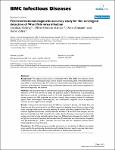First international diagnostic accuracy study for the serological detection of West Nile virus infection
Niedrig, Matthias
Mantke, Oliver Donoso
Altmann, Doris
Zeller, Hervé
Background: The diagnosis of an acute or convalescent West Nile (WN) virus infection can be confirmed by various serological assays such as enzyme immunoassay (EIA), immunofluorescence assay (IFA), or neutralisation test (NT) which are conducted by a growing number of laboratories. However, as the degree of proficiency may vary between laboratories, quality control measures for laboratory diagnostics are essential. Methods: We have performed an external quality assurance (EQA) programme for the serological detection of WN virus infection to assess the diagnostic quality of laboratories. The participating laboratories received a proficiency panel of 10 coded lyophilised test samples comprising four antisera positive for WN antibodies as positive controls, three antisera positive for antibodies against other heterologous flaviviruses plus one multireactive unspecific serum as specificity controls, and two negative serum samples. Results: Twenty-seven laboratories from 20 different countries in Europe, the Middle East, the Americas and Africa participated in this EQA programme. Applying the proficiency criteria of this study, only eight laboratories correctly analysed all samples with their respective EIA, IFA or NT methods. Eighteen laboratories correctly identified between 77.8 and 90% of the samples, and one laboratory identified only 70% correctly with a clear need to eliminate cross-reactivity with other antisera, particularly those elicited by yellow fever virus. Differentiation between the results for IgM and IgG was considered separately and revealed that IgM-antibodies were detected less frequently than IgG-antibodies (p < 0.001). However, the assay used was not a significant technical factor influencing laboratory performance. Conclusion: The EQA programme provides information on the quality of different serological assays used by the participating laboratories and indicates that most need to improve their assays, in particular to avoid cross-reactions with antibodies to heterologous flaviviruses.
No license information

